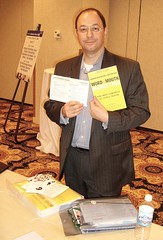Had a chance to meet Andy Sernovitz in Chicago a few weeks back (along with some other great folks). Andy is the CEO of the Word of Mouth Marketing Association, also known as WOMMA.
Have been flipping through his new book on word of mouth marketing, and there are a number of good points and checklists. The one he keeps coming back to: “Put a tell-a-friend form on every page of your website.” (Just checked, and yes, the WOMMA site does this. Excellent consistency!)
Some other things on Andy’s list:
- Create a blog
- Put a special offer in an easily forwardable email
- Come up with one buzzworthy topic — keep it simple
- Let your talkers sign up for a private newsletter
- Do something unexpected
- Be nice
From the “eating our own dogfood” department, here are three examples of ways we’ve built these kinds of tools into Haystack networking.
Number 1: Every network has a “SHARE URL” link
Every network our customers create has a SHARE URL link built in, that allows them — or anyone viewing the network — to send the URL to a colleague easily and quickly. One click, it’s selected, and can be copy-pasted into an email. Simple, fast.
Here’s an example from the Social Media Club haystack.
Number 2: The “Invite” link
Every person registered on the system can also invite others to join the Haystacks to which they belong with two clicks. (We limit the number of invitations to discourage spammers, and only registered users can send invitations.)
Here’s an example from the Speakers Wiki haystack.
Number 3: I can’t tell you about Number 3 yet. It’s in final testing this week prior to the holiday here in the States, but the early feedback is that it’s a big winner, perhaps even game-changing in the business social networking space. If you’re subscribed you’ll know about it as soon as it’s public when we release it into the wild next week.






 Want to come out and connect with others who are thinking about how social media are changing marketing and customer relationships? You may be interested in attending one of the upcoming sessions of
Want to come out and connect with others who are thinking about how social media are changing marketing and customer relationships? You may be interested in attending one of the upcoming sessions of 